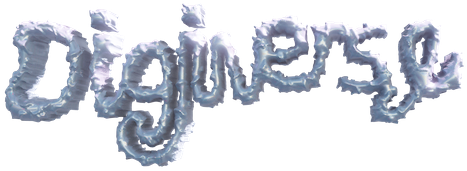Q+A with Digi: The revival of Y2K design
Digi x Eye on Design on why techno-optimism is back and what it says about web3
2022-10-27
Thumbnail: Branding by The Digi Fairy for Peachy Den
Banner: Caroline Fayette
Eye on Design reached out to The Digital Fairy for our thoughts on the rise of the Y2K aesthetic within design, with waves of iridescence and hyper-digital glimmer taking over our screens. Here's what we had to say about the reemergence of millennium tech-utopianism and its connection to attitudes towards web3:
Eye on Design: Iridescent and holographic motifs are often associated with Y2K. What is the context behind this?
Digi: Y2K is an aesthetic that transcends fashion, design, beauty and lifestyle. It shows up in tons of different ways, from blobby retro tech to silver eye makeup. Within Y2K design, there are a few recognisable traits: things like rounded, bloated typefaces, hyper-digital elements like metallics, gloss, mirror and 3D, as well as implied tech elements like loading bars and rendered buttons. Most notably are probably the colours associated with Y2K, such as glossy holographic gradients, watery iridescent colours and shiny silvers. These design elements were super popular during the late ‘90s and early noughties and reflected our excitement about current and rising tech advancements, as well as us naively trying to make sense of our world both on and offline.
EoD: Iridescence is increasingly popular on furniture, on clothes, and in digital spaces. What does it signal, and why do you think it's so popular?
Digi: Iridescence has an alluring and changeable quality that encourages inspection from different perspectives. This curiosity has kept us captivated by iridescence finishes decade after decade. It gives life and movement to otherwise static objects, and pushes the boundaries of what’s possible in digital and physical realms – there’s a hopeful optimism associated with iridescence and its sparkle.
EoD: Given that iridescence is reminiscent of millennium-era Macs, the back of CDs, and even the Gameboy colour, it's being associated with techno-optimism. Do we have-techno optimism in the 2020s?
Digi: Similarly with the millennium, we are currently on the cusp of great technological innovation with the explosion of web3. However, this is not the same techno-optimism, as we have been burnt by the wrongdoings of web2.0 and thus approach web3 with cautious optimism. Iridescence has subsequently matured to reflect this – we see it applied to deeper and moodier tones, compared to the hopeful and naive rainbow tones of the 2000s and 2010s.
EoD: What about gradients, whether rainbow-like or just bicolor, makes them popular in digital spaces?
Digi: Initial digital gradient colours can be associated with video games or early digital renders as designers tried to add depth, texture or imply shine. As software became more advanced, we saw light-reflecting colours like metallics, gloss and iridescence. Similar to this, gradients act as a way of communicating a light source reacting with colour, causing lighter, darker or multicolour areas that feel lit from different directions. Gradients give a 3D, digital and artificial feeling, which is a big part of the Y2K aesthetic. They feel made for a digital world, mainly because everything about them is amplified when seen backlit on a digital screen. Even outside of the aesthetic, gradient colours are a popular way to add dimension, personality and life to online content – this is recognisable in the mass of multicoloured lights and sunset lamps that dominated the early TikTok boom as people tried to make themselves seen.
EoD: Is there some element of anime-inspired aesthetic? Think crystals, soap bubbles, magical-girl transformations?
Digi: Parts of animecore are definitely seen overlapping into the Y2K aesthetic. They share elements like sugary colours, exaggerated tech and over-the-top movement. There is also overlap in attitudes between the two – Y2K has an energised hopefulness for the future that is familiar with the dreamy lights, bright eyes and magical transformations seen in anime. Both aesthetics use tech, motion and flashes of light to communicate a fantasy future that may or may not be rooted in reality.
EoD: As with all revivals, this one will see its way out soon: any idea what it could be replaced with?
Digi: Iridescent and holographic finishes will always be synonymous with our hopefulness for the future, but as we saw with online content, we may ultimately see a rejection of polish and perfection. New considerations offline may also impact visual trends online. As we move into meta-spaces, we are uncovering the environmental impact, specifically emissions, of certain graphics and imagery. As a result, low-res, easy-to-render surfaces and textures may become more favourable to lessen environmental impact.
Read the full article by Angelica Frey here.
✨ Contributing Fairies
- Jane Macfarlane, Creative Brand Director
- Deanna Middleton, Visual Strategist
✨ Digi Reading Recs
- Y2K Aesthetic Gallery (CARI)
For more content like this, explore the rest of the Digiverse, or connect with us on TikTok or Instagram. If you’re a brand or business and want to inspire your audience in innovative ways, reach out to our strategic & creative lab eve@thedigitalfairy.co.uk

Welcome to the Digiverse, your portal to internet enlightenment.
From IRL to URL, digest the best of algorithm-driven culture – news, trends and insights – powered by The Digital Fairy.










